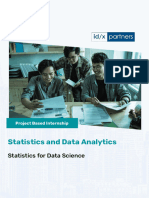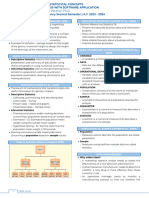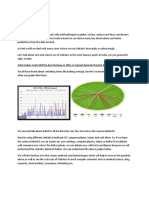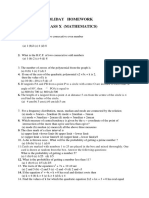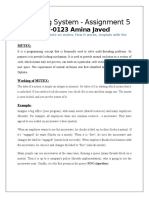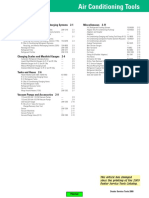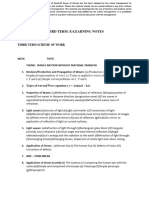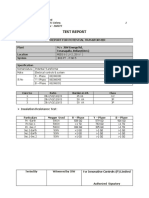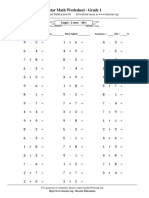#UpSkillWithKalpesh
Day 05
Data Science
Unlocked
From Zero to Data Hero
Statistics Basics for
Data Science
Kalpesh Pathade
@DataSimplified
Statistics(1/3) - Basics 1
� Statistics(1/3) - Basics
I. Introduction to Statistics
What is Statistics?
Statistics is the branch of mathematics that deals with collecting, analyzing,
interpreting, presenting, and organizing data. It provides methods for drawing
meaningful conclusions from data and allows researchers and data scientists to make
informed decisions based on data.
There are two main types of statistics:
Descriptive Statistics: Summarizes and describes the characteristics of a dataset.
Inferential Statistics: Makes predictions or inferences about a population based on
a sample.
Key Concepts in Statistics:
Population: The entire set of items or individuals of interest.
Sample: A subset of the population used to estimate the characteristics of the
population.
Data: Raw facts and figures collected for analysis. Data can be qualitative or
quantitative.
Variables: Characteristics or properties that can be measured or categorized (e.g.,
height, weight, age, gender).
Parameters: Numerical values that describe a population (e.g., population mean,
population variance).
Statistics: Numerical values that describe a sample (e.g., sample mean, sample
variance).
Types of Statistics: Descriptive vs. Inferential
Descriptive Statistics
Statistics(1/3) - Basics 2
� Descriptive statistics is the branch of statistics that involves organizing, summarizing,
and presenting data in a meaningful way. It is used to describe and understand the
basic features of data.
Key Tools in Descriptive Statistics:
1. Measures of Central Tendency: Includes mean (arithmetic average), median
(middle value), and mode (most frequent value)
2. Measures of Dispersion: Includes range (difference between largest and
smallest values), variance (average squared deviation from mean), and standard
deviation (square root of variance)
3. Data Visualization: Includes histograms (distribution representation), bar plots
(categorical data comparison), and box plots (quartile distribution)
Inferential Statistics
Inferential statistics allows data scientists to make generalizations about a population
based on sample data. It helps answer questions such as: "What is the likelihood that
the observed data is due to chance?" and "What are the probable outcomes in future
scenarios?"
Key Tools in Inferential Statistics:
1. Hypothesis Testing: Involves making assumptions (hypotheses) about a population
parameter and testing these assumptions using sample data. Common tests include
the t-test, chi-square test, and ANOVA.
2. Confidence Intervals: A range of values, derived from the sample data, that is likely
to contain the population parameter.
3. Regression Analysis: A method for modeling the relationship between variables.
This includes linear regression for predicting numeric values based on independent
variables.
Applications of Statistics in Data Science
Statistics plays a crucial role in data science. Data scientists use statistical methods to
interpret large datasets, identify trends, and make predictions. Some of the key
applications of statistics in data science include:
1. Exploratory Data Analysis (EDA): Statistics help summarize and visualize datasets
to uncover patterns and relationships within the data.
Statistics(1/3) - Basics 3
� 2. Machine Learning: Statistical techniques such as regression, classification, and
clustering are fundamental in building predictive models. Machine learning
algorithms are built on statistical principles.
3. A/B Testing: Inferential statistics is used to compare two or more variants to
determine which one performs better in terms of user behavior, conversions, or any
other metric.
4. Sampling and Estimation: Since collecting data from an entire population is often
impractical, statistics helps select representative samples and make inferences
about the population.
5. Data Cleaning and Preprocessing: Statistics aids in identifying anomalies, missing
values, and outliers in datasets, enabling effective data preparation.
6. Predictive Analytics: By applying regression models and statistical tests, data
scientists can forecast future trends, sales, customer behavior, and other variables.
II. Data Types and Scales of Measurement
In statistics, understanding the different types of data and the scales of measurement is
crucial as they determine how data can be analyzed and which statistical methods can
be applied.
1. Scales of Measurement
The scale of measurement refers to how data is categorized and quantified. There are
four primary scales of measurement: Nominal, Ordinal, Interval, and Ratio. These
scales determine the operations you can perform on the data (e.g., addition,
subtraction, comparison).
Nominal Scale
The nominal scale is the simplest level of measurement. It involves data that can be
categorized into distinct groups or categories but cannot be ordered or ranked.
Examples: Gender (male, female), Blood type (A, B, O, AB), Marital status (single,
married, divorced)
Key Points:
Categories are mutually exclusive.
Statistics(1/3) - Basics 4
� No inherent order between categories.
Only the mode (most frequent category) can be calculated.
Ordinal Scale
The ordinal scale allows for data that can be ranked or ordered. However, the
intervals between the ranks are not necessarily equal or meaningful.
Examples: Education level (high school, bachelor's, master's), Customer
satisfaction (poor, fair, good, excellent), Ranks in a competition (1st, 2nd, 3rd)
Key Points:
Data can be ordered or ranked.
Median and mode can be calculated.
Differences between ranks are not meaningful (e.g., the difference between
“poorˮ and “fairˮ may not be the same as between “goodˮ and “excellentˮ).
Interval Scale
The interval scale provides data with both ordered values and equal intervals
between them. However, it does not have a true zero point, meaning you cannot
make statements about absolute quantities.
Examples: Temperature (Celsius, Fahrenheit), Calendar years (2020, 2021, 2022)
Key Points:
Equal intervals between values (e.g., 10°C to 20°C is the same as 30°C to 40°C).
There is no absolute zero, so ratios are not meaningful (e.g., 20°C is not “twiceˮ
as hot as 10°C).
Mean, median, and mode can be calculated.
Ratio Scale
The ratio scale is the highest level of measurement. It has all the properties of the
interval scale, plus a true zero point, allowing for meaningful ratios between values.
Examples: Height, Weight, Distance, Time, Income
Key Points:
True zero point means the absence of the measured quantity (e.g., zero height
means no height).
Statistics(1/3) - Basics 5
� Ratios are meaningful (e.g., a person weighing 80 kg is twice as heavy as a
person weighing 40 kg).
Mean, median, and mode can be calculated.
2. Data Types
Data can be categorized into two main types based on whether the data points are
countable or measurable: Discrete and Continuous data.
Discrete Data
Discrete data consists of distinct, separate values that can only take specific,
individual values, usually integers. These are often counts or quantities.
Examples: Number of students in a class, Number of cars in a parking lot, Number
of goals scored in a match
Key Points:
Can only take specific, countable values (e.g., 1, 2, 3, …).
Cannot be subdivided into smaller parts (e.g., you can't have 2.5 students).
Often represented by whole numbers.
Continuous Data
Continuous data can take any value within a given range and can be measured with
great precision. It is often associated with physical quantities.
Examples: Height, Weight, Temperature, Distance, Time
Key Points:
Can take an infinite number of values within a range.
Can be measured to an arbitrary level of precision (e.g., 1.2 meters, 1.25 meters,
1.258 meters).
Can be subdivided into smaller intervals (e.g., time can be measured in
seconds, milliseconds, microseconds).
III. Descriptive Statistics
Statistics(1/3) - Basics 6
� Descriptive statistics involves summarizing and organizing data in a way that provides
useful insights and makes it easier to understand. This can be achieved through
measures of central tendency, measures of dispersion, and percentiles/quartiles.
These statistics help describe the main features of a dataset.
1. Measures of Central Tendency
Measures of central tendency describe the center or typical value in a data set. These
include Mean, Median, and Mode.
Mean
The mean is the arithmetic average of a set of values. It is calculated by summing all
the values in the dataset and dividing by the number of values.
Formula:
∑ xi
Mean =
n
Where xi represents each data point, and n is the total number of data points.
Example: Given the dataset 4, 5, 6, 7, 8 , the mean is:
4+5+6+7+8
=6
5
Key Points:
Sensitive to outliers (extremely high or low values can skew the mean).
Used with interval and ratio data.
Median
The median is the middle value in a dataset when the values are arranged in
ascending or descending order.
If there is an odd number of values, the median is the middle value. If there is an
even number, the median is the average of the two middle values.
Example: For the dataset 4, 5, 6, 7, 8 , the median is 6 (the middle value).
Key Points:
Less sensitive to outliers than the mean.
Statistics(1/3) - Basics 7
� Used with ordinal, interval, and ratio data.
Mode
The mode is the value that appears most frequently in a dataset.
Example: For the dataset 4, 5, 6, 6, 7, 8 , the mode is 6.
Key Points:
A dataset can have one mode (unimodal), two modes (bimodal), or more than
two modes (multimodal).
It can be used with nominal, ordinal, interval, and ratio data.
2. Measures of Dispersion
Measures of dispersion describe the spread or variability of a dataset. These include
Range, Variance, Standard Deviation, and Interquartile Range.
Range
The range is the difference between the highest and lowest values in a dataset.
Formula:
Range = Maximum value − Minimum value
Example: Given the dataset 4, 5, 6, 7, 8 , the range is:
8–4 4
Key Points:
Simple to calculate but can be heavily influenced by outliers.
Variance
Variance measures how far each data point is from the mean of the dataset. It is the
average of the squared differences from the mean.
Formula:
∑(xi − μ)2
Variance =
n
Statistics(1/3) - Basics 8
� Where xi represents each data point, μ is the mean, and n is the number of data
points.
Example: Given the dataset 4, 5, 6, 7, 8 with a mean of 6, the variance is:
(4 − 6)2 + (5 − 6)2 + (6 − 6)2 + (7 − 6)2 + (8 − 6)2 4+1+0+1+4
= =2
5 5
Key Points:
Variance is in squared units, which can be difficult to interpret.
It is used with interval and ratio data.
Standard Deviation
The standard deviation is the square root of the variance. It represents the average
amount of deviation from the mean.
Formula:
Standard Deviation = Variance
Example: For the dataset 4, 5, 6, 7, 8 with a variance of 2, the standard deviation
is:
2 ≈ 1.41
Key Points:
In the same units as the data, which makes it easier to interpret than variance.
It is commonly used in interval and ratio data.
Interquartile Range (IQR)
The interquartile range is the difference between the third quartile (Q3) and the first
quartile (Q1). It measures the spread of the middle 50% of the data.
Formula:
Statistics(1/3) - Basics 9
� IQR = Q3 − Q1
Key Points:
Less sensitive to outliers than the range.
Used to detect outliers by defining boundaries outside of 1.5 * IQR from the
quartiles.
Suitable for ordinal, interval, and ratio data.
3. Percentiles and Quartiles
Percentiles are values that divide a dataset into 100 equal parts. The pth percentile
is the value below which p% of the data falls.
Example: The 50th percentile (median) divides the data in half.
Quartiles are special percentiles that divide the dataset into four equal parts. The
first quartile (Q1) is the 25th percentile, the second quartile (Q2) is the 50th
percentile (median), and the third quartile (Q3) is the 75th percentile.
Q1: 25th percentile, the point where 25% of the data is below.
Q2: 50th percentile, the median.
Q3: 75th percentile, the point where 75% of the data is below.
Key Points:
Box plots often represent quartiles visually, showing the median, IQR, and potential
outliers.
The IQR is based on quartiles and is a measure of the spread of the middle 50% of
the data.
IV. Data Visualization
Data visualization helps to represent and communicate data insights effectively. Various
types of charts and plots are used to analyze data patterns, trends, and relationships.
1. Histograms
Statistics(1/3) - Basics 10
� Purpose: To show the distribution of a dataset.
Description: A histogram is used to display the frequency distribution of a
continuous variable. It divides the data into bins and shows how many data points
fall within each bin.
Example: A histogram for the ages in a dataset, which could be divided into bins like
20-30, 30-40, etc.
Key Points:
Helps to understand the distribution and spread of the data.
Too many bins may lead to overfitting; too few bins may oversimplify the data.
Chart:
2. Bar Plots
Purpose: To compare values across discrete categories.
Description: Bar plots display categories along the x-axis and their corresponding
values on the y-axis. Each bar represents one category.
Example: A bar plot showing the number of sales for each product category.
Key Points:
Best used for categorical data.
Statistics(1/3) - Basics 10
� Useful to compare values across different categories.
Chart:
3. Pie Charts
Purpose: To represent parts of a whole.
Description: Pie charts display data as slices of a pie, where each slice represents a
proportion of the total.
Example: A pie chart showing the percentage distribution of sales across different
regions.
Key Points:
Suitable for proportional data.
Overuse of pie charts can be misleading, especially with many categories.
Chart:
Statistics(1/3) - Basics 11
� 4. Box Plots
Purpose: To visualize the distribution of a dataset and identify outliers.
Description: Box plots display the minimum, first quartile (Q1), median (Q2), third
quartile (Q3), and maximum of a dataset. They also show outliers.
Example: A box plot showing the distribution of test scores in a class.
Key Points:
Useful for identifying outliers and understanding the spread of data.
Also used for comparing distributions between multiple datasets.
Chart:
Statistics(1/3) - Basics 12
� 5. Scatter Plots
Purpose: To explore the relationship between two continuous variables.
Description: Scatter plots display individual data points on a two-dimensional plane,
where each point represents a pair of values from two different variables.
Example: A scatter plot showing the relationship between hours studied and exam
scores.
Key Points:
Great for detecting correlations or trends between two variables.
Outliers are clearly visible.
Chart:
Statistics(1/3) - Basics 13
� 6. Density Plots
Purpose: To estimate the distribution of a continuous variable.
Description: A density plot is a smoothed version of a histogram. It shows the
probability density function of a continuous variable.
Example: A density plot showing the distribution of test scores for a group of
students.
Key Points:
Provides a smoother visualization of the distribution compared to histograms.
Useful for comparing multiple distributions.
Chart:
Statistics(1/3) - Basics 14
� V. Probability Basics
Probability is a branch of mathematics that deals with calculating the likelihood of an
event occurring. In data science, probability theory is used to model uncertainty, predict
outcomes, and understand the randomness in data.
1. Probability Theory
Probability theory is the mathematical framework used to describe and quantify
uncertainty. It assigns a probability to each possible outcome of a random event. The
probability of an event EE is a number between 0 and 1, where 0 means the event will
not occur and 1 means the event will certainly occur.
Probability Formula:
Number of favorable outcomes
P (E) =
Total number of possible outcomes
Key Properties of Probability:
The probability of any event is between 0 and 1: .
0 ≤ P (E) ≤ 1
Statistics(1/3) - Basics 15
� The sum of the probabilities of all possible outcomes of a random experiment
equals 1.
Example:
When rolling a fair six-sided die, the probability of rolling a 3 is:
1
P (3) =
6
2. Sample Spaces, Events
Sample Space:
The
sample space is the set of all possible outcomes of a random experiment. For
example, when flipping a coin, the sample space is Heads, Tails}.
Event:
An
event is a subset of the sample space, which may consist of one or more outcomes.
For example, in the case of a die roll, an event could be the outcome of rolling an
even number (i.e., 2, 4, 6 ).
Example:
For a die roll, the sample space is 1, 2, 3, 4, 5, 6 .
An event might be "rolling an even number," which is the set 2, 4, 6 .
Key Points:
The total number of possible events is the number of subsets of the sample
space.
The probability of an event is the sum of the probabilities of the outcomes within
the event.
3. Conditional Probability
Conditional Probability is the probability of an event occurring given that another
event has already occurred. It is denoted as P(A∣B), meaning the probability of
event A occurring given event B has occurred.
Formula:
Statistics(1/3) - Basics 16
� P (A ∩ B)
P (A∣B) = P (B)
Where:
P(A∩B) is the probability that both events A and B occur.
P(B) is the probability of event B.
Example:
If you draw a card from a deck of 52 cards, the probability of drawing a red card
(event A) given that the card is a heart (event B) is:
P (Red ∩ Heart) 1 1
P (Red|Heart) = = ÷ =1
P (Heart) 4 4
Key Points:
Conditional probability helps in situations where the outcome of one event
affects the probability of another.
Independence of events impacts conditional probability.
4. Independent and Dependent Events
Independent Events:
Two events are
independent if the occurrence of one event does not affect the occurrence of the
other. Mathematically, two events A and B are independent if:
P (A ∩ B) = P (A) × P (B)
Example: Tossing a coin and rolling a die are independent events, as the result
of one does not affect the result of the other.
Dependent Events:
Two events are
dependent if the occurrence of one event affects the probability of the other.
Mathematically, if A and B are dependent, then:
P (A ∩ B) =f P (A) × P (B)
Statistics(1/3) - Basics 17
� Example: Drawing cards from a deck without replacement is an example of
dependent events, as the first card drawn affects the probabilities of
subsequent draws.
Key Points:
Independence simplifies probability calculations.
Dependent events require more complex calculations, often involving conditional
probability.
5. Bayes' Theorem
Bayes' Theorem is a powerful tool in probability theory that allows you to update
the probability of an event based on new evidence. It is particularly useful when
dealing with conditional probabilities.
Formula:
P (B∣A) × P (A)
P (A∣B) =
P (B)
Where:
P(A|B) is the probability of event A given that event B has occurred.
P(B|A) is the probability of event B given that event A has occurred.
P(A) and P(B) are the prior probabilities of events A and B, respectively.
Example:
Suppose 1% of the population has a disease (event A), and a diagnostic test for the
disease is 95% accurate (event B). If a person tests positive, what is the probability
they actually have the disease? Using Bayesʼ Theorem, you can calculate this
probability based on the accuracy of the test and the prevalence of the disease in
the population.
Key Points:
Bayesʼ Theorem is essential for updating beliefs in light of new data.
It plays a central role in machine learning, especially in classification tasks (e.g.,
Naive Bayes classifiers).
Statistics(1/3) - Basics 18
�Statistics(1/3) - Basics 19














